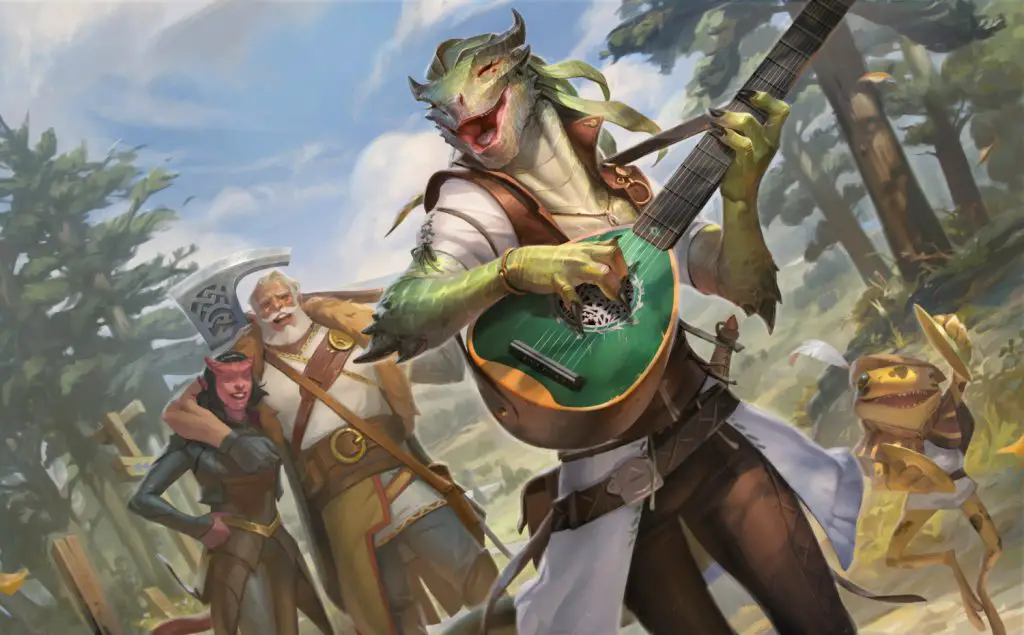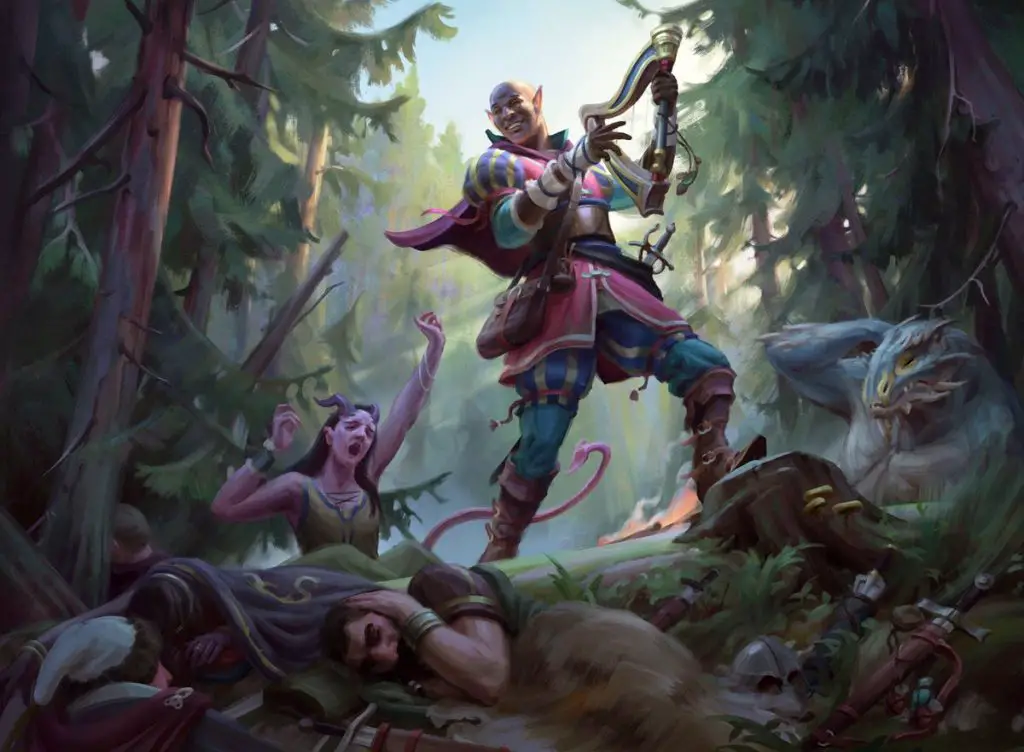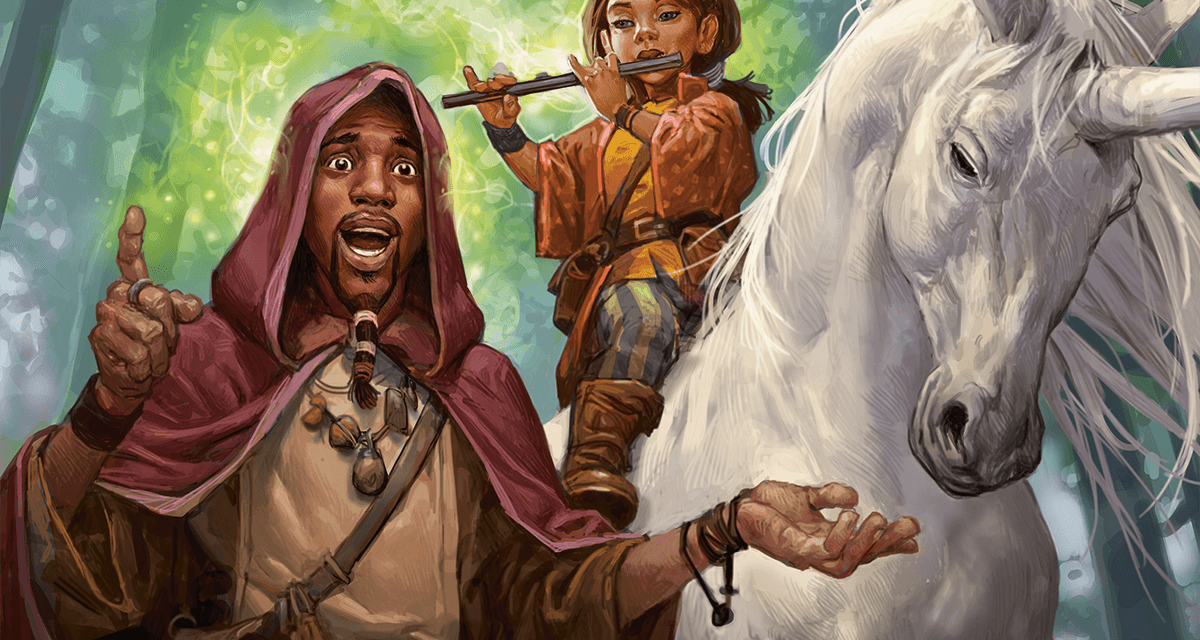Today we’re taking a look at one of my favorite 5e Bard subclasses: the College of Glamour.
Bards who choose this path weave the charms and wits of the Fey into their performances. They are masters of gaining the admiration of those around them through both talent and enchantment.
Also, I love that this subclass gives some major Bowie vibes. If there are two things that I will literally always want in a D&D game, it’s Fey stuff and David Bowie.
So let’s get right into this full subclass guide for the College of Glamour Bard in D&D 5e!
What is the College of Glamour Bard in D&D 5e?
Bards of the College of Glamour commonly learn their abilities from Fey creatures like Satyrs or Eladrin. If the Bard in question hasn’t learned their techniques in the Feywild, they almost certainly learn them from someone who did.
Fey magic is particularly fond of enchantments and illusions to capture the hearts and minds of others. Applying this magic to the Bardic Arts creates something particularly special and powerful. It can soothe an angry dragon or convince a captor to let the Bard go unharmed.
Good Bards of the College of Glamour use their abilities to spread joy. They lift up the people in downtrodden or ravaged areas while standing as a beacon of hope against the oppressors.
Bards who are evil or otherwise morally questionable might instead use their enchantments at the expense of a community. They might seek to gain position or power as they magically command the admiration of everyone around them.
The College of Glamour Bard subclass was introduced in the excellent Xanathar’s Guide to Everything sourcebook. It appears alongside the College of Swords and the College of Whispers subclasses.
Role in the Party
As with most Bard subclasses in 5e, the College of Glamour Bard is focused heavily towards a supporting role.
These Bards make a very good “face” for the party by handling issues that rely on Charisma. Meanwhile, in combat, they are best suited to buffing their allies and magically locking down their enemies with charms and illusions.
The abilities of the Glamour Bard work very well with most of the spells on the Bard’s spell list. However, there is a slight catch…
Most people view Bards as the “little bit of everything” or “jack of all trades” type of class.
In most cases, I’d say that’s reasonably true, but the College of Glamour isn’t quite one of those cases. You might have a few tricks up your sleeve, but your focus should be very heavily on ways to buff your allies and debuff/incapacitate your enemies.
Psst! One of those tricks should be my Complete Bard Class Guide! (Just saying!)
College of Glamour Bard Features 5e
So now that we’ve clarified what your role in the party is as a College of Glamour Bard, let’s take a closer look at your features.
Mystical fey enchantments, unique ways to support your party, and a particularly interesting use of your Bardic Inspiration abound with this subclass!
Mantle of Inspiration (Level 3)
We’re starting out big with this first feature at level 3: Mantle of Inspiration!
As a bonus action, you can expend one use of your Bardic Inspiration to grant yourself a wondrous appearance.
When you do so, choose a number of creatures you can see and that can see you within 60 feet of you, up to a number equal to your Charisma modifier (minimum of one). Each of them gains 5 temporary hit points.
When a creature gains these temporary hit points, it can immediately use its reaction to move up to its speed, without provoking opportunity attacks.
The number of temporary hit points increases when you reach certain levels in this class, increasing to 8 at 5th level, 11 at 10th, and 14 at 15th level.
As far as new uses for Bardic Inspiration go, this is simply incredible.
You’re able to add a pretty large amount of extra hit points to your party’s side of the field with this. If you have an 18 Charisma Score at level 3, you’re able to give 4 creatures a combined 20 hit points of “buffer” HP to keep them in the fight.
Keeping in mind that temporary hit points don’t stack, it’s still a solid defensive ability that your allies (especially the ones on the front lines) will appreciate!
Related: Temporary Hit Points Explained
While the temporary hit points a single use of Mantle of Inspiration provides are slightly less awesome at the higher levels, the mobility that it grants your party is always fantastic.
As combat goes on, it might be necessary to reposition or regroup which gives this some great defensive utility.
On the other hand, if you feel like that villain is about to try and make their escape, popping this ability can help your party close the gap and dogpile him!
Just remind your allies that this movement will use their reaction. If someone is lining up for an attack of opportunity or keeping a counterspell handy, they might not want to use this extra movement.
Much like the other Bard subclasses’ abilities in 5e, you’ll be using this special form of Bardic Inspiration a lot.
Does Mantle of Inspiration Affect Yourself?
Mantle of Inspiration is the subject of a fair amount of discussion. It’s admittedly worded a little weirdly which has made many players wonder if this ability’s buff includes themselves.
Which means…
Order! Order! Rules Court is now in session!
Let’s start by looking at the ability’s requirements:
- It costs a bonus action and one use of your Bardic Inspiration.
- The creatures you choose must be within 60 feet of you.
- You must be able to see the chosen creatures and they must be able to see you.
There are no issues with the first two requirements. It’s the third that causes the most confusion.
If you are invisible or concealed by a spell like Darkness, it’s useless. Likewise, if another ally is invisible or concealed, they cannot benefit from your Mantle of Inspiration.
But what about yourself?
Personally, I would rule that Mantle of Inspiration can include the Bard that is using it.
Here’s my reasoning:
I’ve never seen someone argue that certain spells that use the same/similar phrasing couldn’t be used on oneself. This means spells like Water Breathing, Healing Word, or Levitate (which specify “creature(s) that you can see within range”) set a precedent.
Compare this to the description of Bardic Inspiration on page 53 of the Player’s Handbook which states “choose one creature other than yourself within 60 feet of you who can hear you.” If Mantle of Inspiration didn’t affect the Bard using it, wouldn’t it specifically say so?
Plus, it’s nice for the College of Glamour Bard to also be able to gain a benefit from expending a Bardic Inspiration die.
Even if it means invoking “The Rule of Cool,” I’m firmly sticking to this ruling!

Enthralling Performance (Level 3)
Your second level 3 feature from the College of Glamour is pretty firmly for out-of-combat situations.
Calling upon the seductive fey magic that you weave into your art, you’re able to charm others with your performance.
If you perform for at least 1 minute, you can attempt to inspire wonder in your audience by singing, reciting a poem, or dancing.
At the end of the performance, choose a number of humanoids within 60 feet of you who watched and listened to all of it, up to a number equal to your Charisma modifier (minimum of one).
Each target must succeed on a Wisdom saving throw against your spell save DC or be charmed by you.
While charmed in this way, the target idolizes you. It speaks glowingly of you to anyone who talks to it and it hinders anyone who opposes you. It avoids violence unless it was already inclined to fight on your behalf.
Because your targets have no idea that you have tried to charm them with this ability, it can make for a great subtle way of gaining allies or information. You just have to perform for at least one minute which is fairly easy to pull off out of combat in most cases.
With a reasonable performance check in a place that makes sense (like a tavern), you should be able to pretty easily keep your targets’ attention for one minute.
Your new friends are charmed by you for 1 hour unless they take damage, you attack them, or they witness you attacking/damaging their allies. You can use this ability once per short or long rest.
Uses for this ability are pretty varied.
If an agent of the Thieves’ Guild tends to favor a tavern that you perform at, you might be able to charm them and later convince them to tell you the password to the underground hangout.
Likewise, you might be able to buddy up with a noble who can graciously agree to help fund your next expedition.
The lack of risk of being discovered for trying to enchant others is what makes this ability so appealing to me. It can lead to your character making new friends and useful contacts between adventures that might otherwise have not spoken to you or would have reacted poorly to you attempting to charm them.
Recommended: Guide to Using Bardic Inspiration in D&D 5e!
Mantle of Majesty (Level 6)
At level 6, you just might decide that it feels good to be a little bossy.
As a bonus action, you cast Command without expending a spell slot, and you take on an appearance of unearthly beauty for 1 minute or until your concentration ends (as if you were concentrating on a spell.) During the time, you can cast Command as a bonus action on each of your turns without expending a spell slot.
A creature charmed by you automatically fails its saving throw against the Command you cast with this feature.
Once you use this feature, you can’t use it again until you finish a long rest.
For a full minute (that’s 10 combat rounds), you get to cast Command as a bonus action each round. The potential for absolute craziness is most certainly here!
Keeping in mind that you’re only targeting one creature at a time with this (you can’t increase the amount because this isn’t using a spell slot), you can completely force an enemy to waste their turns.
Additionally, remember that they automatically fail their saving throw against this feature if you’ve already charmed them with another spell or ability (like Charm Person)!
You might make a creature drop its weapon, lie down on the ground, or run away. This is especially useful if there’s a particular “high-threat” enemy that you’re worried about and can manage to charm in this way.
The biggest thing to look out for here is your action economy and the rules of spellcasting.
Using your bonus action for something like Bardic Inspiration is an opportunity where you could have issued another casting of Command. Likewise, because you’re casting Command (a first-level spell) as a bonus action, you aren’t able to cast anything higher than a cantrip with your action.
You’ll get the best use out of this in smaller encounters (that is, not fighting a horde of goblins or whatever) or in encounters where there is a primary threat that you want to keep locked down while you deal with its smaller allies.
Also Check Out: The Best Bard Spells By Level in D&D 5e!
Unbreakable Majesty (Level 14)
The capstone ability for the College of Glamour Bard, Unbreakable Majesty, is absolutely fantastic.
Not only does your now-permanent appearance change create some awesome roleplaying potential, but it also provides a fantastic mechanical benefit as well!
As a bonus action, you can assume a magically majestic presence for 1 minute or until you are incapacitated.
For the duration, whenever any creature tries to attack you for the first time on a turn, the attacker must make a Charisma saving throw against your spell save DC.
On a failed save, it can’t attack you on this turn, and it must choose a new target for its attack or the attack is wasted. On a successful save, it can attack you on this turn, but it has disadvantage on any saving throw it makes against your spells on your next turn.
Taking the most literal and extreme forms of “beauty rest,” you can use this once per short or long rest.
By activating this feature, you basically shut down melee attackers.
If they fail their save and don’t have another target in range, they just waste their attack. If they succeed on that save, they’re at disadvantage against whatever spells you’re throwing at them on your next turn.
There tend to be fewer enemies who are good at Charisma saves, so your odds of them failing are pretty good. This is kind of awkward, honestly, because this feature is possibly at its most potent when they succeed!
As a level 14+ Bard, you have countless ways to enchant and infuriate your enemies. The fact that they’ll be making those saves at disadvantage just makes you even more capable of derailing every plan your DM had for this encounter.
Combining this with Mantle of Majesty takes two turns but results in you being the undisputed master of the battlefield.
No, seriously! Everything is charmed and they can’t do anything about it!

Connections
Because the Fey and their influences have a major tendency to pop in and out of the Material Plane, there are many ways that you might have become a College of Glamour Bard.
Did you find yourself in the Feywild learning these techniques? If not, how did you come to learn them? With so much power over the minds and hearts of others, do you use these abilities for good or for selfish reasons?
The typical College of Glamour Bard surrounds themselves with people and things that are both useful and beautiful. Between that, your striking appearance, and your indisputable talent as a Bard, what kind of reputation have you developed?
Let’s be honest: for you, NOT standing out in a crowd is worse than death!
That reputation might be pushing you to expand your horizons (and influence) by becoming an adventurer. You might be seeking inspiration for your next song, story, or iconic look.
Also Check Out: Magical Secrets for Bards in D&D 5e
Is the College of Glamour Bard Good?
In most campaigns, a College of Glamour Bard can be an absolute support powerhouse.
They probably won’t be as fun to play in a huge dungeon crawl where it’s unlikely to meet many other people. So much of the “heart” of this subclass relies on interacting with others and basking in their admiration of you.
That’s not to say that they’re useless in a dungeon crawl, but you’re unlikely to get the best taste of everything that this subclass has to offer in such a campaign.
However, it’s unfair to paint this subclass as one that exclusively belongs in an intrigue campaign. Their abilities are perfectly suited to make a big splash in combat situations just as well as in social interactions.
If you’re the type of player who likes to focus on supporting your allies with potent buffs and taking control (literally) of combat situations (and looking good doing it!), then the College of Glamour is an excellent choice!
Your bonus action is in high demand with your various abilities, so you’ll want to be mindful of that.
If you are able to build a strong synergy with your party, there’s no situation that won’t give your character all of that wonderfully intoxicating attention!
To see how the College of Glamour stacks up against the other Bard Colleges in 5e, check out the complete subclass ranking!
Conclusion – Guide to the College of Glamour Bard in D&D 5e
*begins strumming on a lute*
So, that pretty much wraps up this guide to the College of Glamour Bard in D&D 5e.
The Fey influence on this class adds so much eccentric flavor for you to play with. You might look at famously charming (*cough cough* actually Fey *cough*) celebrities like David Bowie, Tim Curry, Lady Gaga, Tilda Swinton, Jeff Goldblum, or Prince for inspiration.
Has it been one minute yet?
Good!
Yes, yes, I know that little song I played on the lute was incredible, but you’re so kind for saying so.
Say, since we’re such good friends now, could you do me a favor?
You can sign up for my newsletter just down there. That way I can always let you know when I’ve got new articles published to help make your D&D game awesome!
You can also follow me on Facebook and Twitter.
If you found this article helpful and want to support the site, you can buy me a coffee here! (It’s not expected, but very appreciated!)









